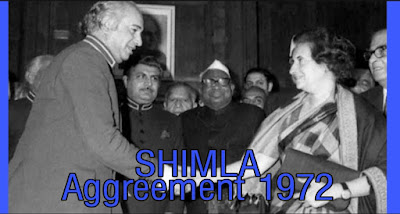India-Pakistan Dispute on Junagadh, Jodhpur, and Kashmir
lapse of paramount
Congress, through a resolution on 15 June 1947, held that on the lapse of paramountcy, the will of the people of concerned states would be required to ascertain their choices as the lapse of paramountcy did not tantamount to the independence of a state. With this interpretation, the Congress raised objections when the Maharaja of Jodhpur began to negotiate an accession with Pakistan. India insisted on its interpretation in the case of Junagadh. A referendum on Junagadh happened and its population voted in favor of India.
The instrument of accession and Kashmir
Kashmir was ruled by Hari Singh. In September 1947, there was communal trouble in Poonch province in the state. Simultaneously, Pakistani tribesmen had started pouring in and have unleashed a campaign of carnage in other areas reaching up till Srinagar.
In October 1947, Hari Singh requested arms and troop support from India to stop the Pakistani-sponsored menace. As Hari Singh had not acceded either to India or Pakistan, troops from India could not be sent. Mountbatten asserted that the accession should be determined by a plebiscite after the tribesmen have been driven out of Kashmir. Nehru accepted the views of Mountbatten.
It was decided by Nehru to inform Hari Singh that only if Hari Singh acceded to India would there be any troop commitment. Nehru, however, clarified that such accession is conditioned, and once law and order are restored, the will of the Hari Singh signed the instrument of accession and sent a letter to Nehru to that effect.
Standstill Agreement with Pakistan
In the letter, Hari Singh stated that Kashmir had signed a standstill agreement with Pakistan. As per the agreement, Pakistan provided postal and telegraph services in the state.
Hari Singh also complained that Pakistan had put a lot of pressure on him, and one of the pressure tactics was the tribal raids. He wrote that in this emergency, instead of allowing Pakistan to destroy his state, he preferred concluding an instrument of accession with India.
The Indian government accepted the accession and decided to provide military help to Kashmir, Pakistan immediately declared that the accession was an act of fraud and it summarily rejected the accession.
 |
| Jammu Kashmir Disputed Map |
The intervention of the UN in the Kashmir Dispute
The challenge of the legality of the accession by Pakistan was an unsound political move. Indian policy was clear-it was aimed at driving out invaders from Kashmir.
Once law and order would be restored, there would be a plebiscite under the observation of the UN. Mountbatten urged Nehru that an international agency like the UN can ensure impartiality in the plebiscite.
On 15 January 1948, India argued in the UN that after normalcy prevailed in the state, there would be a plebiscite under the auspices of the UN.
The UN subsequently established a UN commission for India and Pakistan with the power to exercise mediatory influence. As the UN Commission for India and Pakistan (UNCIP) came to the subcontinent, there arose disagreements over demilitarisation in Kashmir.
Raise of Article 370
In 1949, India included representatives of Kashmir in its Constituent Assembly and worked on Article 370. Pakistan immediately raised objections to the same. India clarified that as its Constitution was being discussed, the Kashmir region could not be left out. However, India asserted that the inclusion of representatives of Kashmir did not change its position on the ground.
India assured that after the plebiscite if Kashmir decided to go the other way, its representation in the Indian Parliament would automatically cease. India further clarified that the instrument of accession was conditional on a plebiscite but was legal.
The Indian Constituent Assembly debated about an Article 370 (which was debated as Article 306A) to give representation to Kashmir till conditions conducive for a plebiscite were created.
The UNCIP yet again made an attempt under McNaughton's leadership to create a conducive condition for a plebiscite by advocating demilitarisation. However, the UNCIP failed and the UNSC terminated the UNCIP in 1950 and appointed Sir Owen Dixon as the UN Representative to the Security Council. Owen Dixon again proposed the idea of a plebiscite after demilitarisation.
Establishment of separate Constituent Assembly
In 1951, the Indian government supported the creation of a Constituent Assembly of the state of Kashmir which would frame its own Constitution but India clarified that it remained committed to a plebiscite and against forced marriages.
The Constituent Assembly of Kashmir adopted a Constitution for Kashmir on 17 November 1956.
The Constitution declared that Kashmir was an integral part of India. Though Pakistan objected to this provision, India clarified that the legality of Kashmir's accession to India (as happened in October 1947) could not be challenged but that did not change India's position of a plebiscite to allow the Kashmiris to determine their future, provided conducive conditions are created.
India alleged that the Pakistani invasion of Kashmir and the subsequent Pakistani membership of SEATO and Baghdad pact in 1953 and 1954 had not created a condition conducive for a plebiscite. India also alleged that Pakistan had not withdrawn its troops on the other side of the ceasefire line.
India, by 1960, began to assert that it would not accept international mediation and would resort to a bilateral dialogue with Pakistan over Kashmir but continue to support the plebiscite. India advocated a shift from treating the Kashmir problem as a world question to treating it as a domestic issue.
When Pakistani tribesmen had invaded Kashmir, the UNCIP was instructed to work jointly with the two states and create a condition conducive for a plebiscite. To immediately halt the hostilities, the UNCIP, through negotiations, helped India and Pakistan sign an agreement in 1949 in Karachi.
India alleged that the stalemate over Kashmir could not end and a plebiscite could not happen as Pakistan did not withdraw its troops from the PoK which was a necessary condition for restoration of peace leading to a future plebiscite.
As time progressed, in 1965, Pakistan launched another conflict with India. The Indian army gave a befitting response to Pakistan.
In the subsequent Soviet-brokered negotiations, a Tashkent Agreement was concluded and both sides agreed to maintain a status quo. In 1971, in the war with East Pakistan, as explained in the previous section, India yet again gave a serious blow to Pakistan by slicing of Bangladesh from its control.










